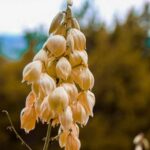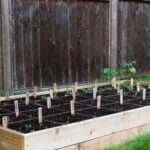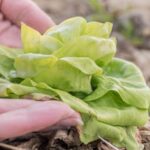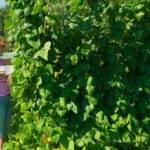Illinois is home to a wide array of vegetable gardens, each uniquely diverse in their offerings and challenges. From the rich soil of the plains to the unique climates throughout the state, Illinois provides an ideal environment for growing a variety of vegetables.
In this article, we will explore the essential elements for establishing and maintaining good Illinois vegetable gardens, including the best vegetables to grow, soil preparation, climate considerations, pest and disease management, watering and irrigation techniques, harvesting and preserving tips, as well as success stories that offer valuable insights.
With its fertile soil and varying climates, Illinois offers an excellent opportunity for growing a wide range of vegetables. Understanding the unique characteristics of Illinois’ landscape is crucial in creating successful vegetable gardens. By implementing proper techniques and strategies tailored to Illinois’ specific conditions, gardeners can maximize their yields while cultivating healthy and thriving crops.
Throughout this article, we will provide comprehensive guidance on how to create and maintain flourishing vegetable gardens in Illinois. Whether you are a seasoned gardener or just starting out, our in-depth exploration of Illinois’ diverse vegetable gardens aims to equip you with the knowledge and resources necessary for achieving a bountiful harvest in this unique state.
The Best Vegetables to Grow in Illinois
When it comes to creating good Illinois vegetable gardens, it’s essential to know which vegetables thrive in the state’s unique climate and soil. Illinois has a diverse range of climates, from hot and humid summers to cold and snowy winters, making it important for gardeners to carefully select their crops. Some vegetables are better suited to Illinois’ conditions than others, and by choosing the right ones, you can ensure a bountiful harvest.
One of the best vegetables to grow in Illinois is tomatoes. They are well-suited to the state’s warm summers and can be grown in both traditional garden beds or containers. Additionally, leafy greens like lettuce, spinach, and kale are also excellent choices for Illinois vegetable gardens. These cool-weather crops can be planted in early spring or late summer for a continuous harvest throughout the year.
Another vegetable that thrives in Illinois is sweet corn. With its warm weather requirements and rich soil preferences, sweet corn grows exceptionally well in the state. And for those looking for a versatile and easy-to-grow option, peppers are a great choice for Illinois gardens. Whether you prefer bell peppers, jalapenos, or habaneros, these plants will produce an abundant crop with proper care.
| Vegetable | Best Growing Season |
|---|---|
| Tomatoes | Summer |
| Lettuce | Spring/Fall |
| Sweet Corn | Summer |
| Peppers | Summer/Fall |
By selecting these top vegetables that thrive in Illinois’ climate and soil, gardeners can set themselves up for success when creating their own Illinois vegetable gardens.
Tips for Soil Preparation
Illinois is a state with a diverse range of soil types, which can pose both challenges and opportunities for gardeners. Understanding the unique soil characteristics of Illinois is crucial for preparing your garden for successful vegetable growth.
The most common soil types in Illinois include loam, silt, and clay, each with their own advantages and drawbacks for growing vegetables. Loamy soil is generally considered ideal for gardening due to its balanced combination of sand, silt, and clay, which provides good drainage while retaining moisture and nutrients.
For those dealing with less-than-ideal soil conditions, there are several strategies that can be employed to improve soil quality. One popular method is the addition of organic matter such as compost or manure, which can help improve drainage in heavy clay soils and increase water retention in sandy soils. Soil testing is also highly recommended to determine the pH levels and nutrient content of your soil, allowing you to make any necessary amendments before planting.
An example of this diversity can be seen in the success stories of various Illinois vegetable gardens. For instance, some gardeners have found great success by implementing raised bed gardening techniques to overcome poor soil quality, while others have applied precision agriculture methods to optimize their soil’s nutrient levels for specific crops. By understanding the unique characteristics of Illinois soil and employing appropriate preparation techniques, gardeners can set themselves up for a bountiful harvest from their vegetable gardens.
| Soil Characteristics | Recommended Strategy |
|---|---|
| Loamy Soil | Add organic matter such as compost or manure |
| Clay Soil | Implement raised bed gardening techniques |
| Sandy Soil | Add organic matter to increase water retention |
Climate Considerations
Illinois is a state known for its diverse climates, ranging from humid continental in the north to subtropical in the south. This diversity can pose both challenges and opportunities for vegetable gardeners. Understanding the climate considerations in Illinois is crucial for adapting your garden for optimal vegetable production.
First and foremost, it’s important to consider the USDA hardiness zone of your specific location in Illinois. This will determine which vegetables are best suited for your area and when they should be planted. Some good options to consider based on Illinois’ climate include:
- Tomatoes
- Peppers
- Cucumbers
- Green beans
- Squash
In addition to considering hardiness zones, it’s essential to be mindful of temperature fluctuations and frost dates. In northern parts of Illinois, where the growing season is shorter, cold-tolerant vegetables like broccoli, kale, and carrots may be more suitable.
Another key consideration is the variability of rainfall across Illinois. While some parts of the state experience ample rainfall, others may face drought conditions. Implementing proper irrigation systems and water conservation techniques can help ensure that your vegetable garden remains healthy regardless of precipitation levels.
Lastly, being aware of microclimates within your garden space can also make a significant impact on vegetable production. Southern-facing slopes tend to receive more sunlight while low-lying areas may be prone to frost pockets. By understanding these microclimates, you can strategically plant your vegetables for maximum growth potential.
Navigating the various climates in Illinois requires careful planning and consideration, but with the right strategies in place, you can cultivate a successful vegetable garden that thrives despite the state’s diverse weather patterns.
Pest and Disease Management
When it comes to maintaining a thriving vegetable garden in Illinois, pest and disease management is crucial. There are a variety of pests and diseases that can wreak havoc on your crops, but with the right strategies, you can keep your garden healthy and productive.
Companion Planting
One effective strategy for managing pests in your Illinois vegetable garden is companion planting. This involves planting certain vegetables, herbs, or flowers together to help control pests naturally. For example, planting marigolds near your tomatoes can help repel nematodes, while planting basil near your tomatoes can help repel mosquitoes and other insects.
Natural Predators
Another way to manage pests in your Illinois vegetable garden is by attracting natural predators. Ladybugs, praying mantises, and lacewings are just a few examples of beneficial insects that feed on common garden pests like aphids and caterpillars. By creating a welcoming environment for these natural predators, you can reduce the need for chemical pesticides.
Disease Prevention
In addition to managing pests, it’s important to take steps to prevent diseases from taking hold in your Illinois vegetable garden. One key tip is to avoid overhead watering, as this can promote the spread of fungal diseases. Instead, water at the base of plants or use drip irrigation to keep foliage dry. Additionally, practicing crop rotation and keeping the garden free of debris can help prevent the spread of disease.
By implementing these practical strategies for pest and disease management in your Illinois vegetable garden, you can ensure that your crops stay healthy and productive throughout the growing season. With a little diligence and proactive planning, you can enjoy a bountiful harvest of fresh produce from your own backyard.
Watering and Irrigation
When it comes to maintaining good Illinois vegetable gardens, proper watering and irrigation techniques are crucial for ensuring the health and success of your crops. Illinois experiences a variety of climates, from hot and humid summers to cold and snowy winters, which can impact the watering needs of your garden. By understanding the importance of proper watering techniques and implementing effective irrigation strategies, you can help your vegetable garden thrive in the diverse conditions of Illinois.
To ensure that your Illinois vegetable garden receives adequate water, consider implementing the following techniques:
- Mulching: Mulching around the base of your plants can help retain soil moisture, reduce water evaporation, and regulate soil temperature. Organic mulches such as straw or wood chips are particularly effective in helping to conserve water in Illinois’ varying climates.
- Drip Irrigation: Using a drip irrigation system can deliver water directly to the root zone of your plants, minimizing water waste through evaporation or runoff. This method also helps prevent common issues such as leaf diseases that result from overhead watering.
- Watering Schedule: Establishing a consistent watering schedule based on the specific needs of your crops and the prevailing weather conditions is essential for promoting healthy growth. Be mindful of rainfall patterns in Illinois and adjust your watering frequency accordingly.
By incorporating these watering and irrigation techniques into your gardening practices, you can significantly improve the health and productivity of your Illinois vegetable garden. Remember that adequate hydration is essential for vegetables to develop properly and resist stressors such as heatwaves or drought periods-especially in a state with varied climates like Illinois.
Harvesting and Preserving
When it comes to your Illinois vegetable garden, all your hard work and effort will pay off when it’s time to harvest and preserve your bountiful produce. Maximizing the yield of your garden and preserving your harvest for future use is essential for getting the most out of your gardening efforts. Here are some helpful tips to make the most of your harvest in Illinois.
Harvesting Tips
One of the keys to a successful harvest is knowing when to pick your vegetables. For example, tomatoes should be picked when they are fully colored and slightly soft to the touch, while bell peppers should be harvested when they reach full size and color. It’s important to regularly check on your garden and harvest vegetables at their peak ripeness to ensure the best flavor and quality.
Another important factor in maximizing your yield is harvesting regularly. By picking vegetables as they reach maturity, you can encourage more production from the plants. This also prevents overripening or spoilage, ensuring that you get the most out of each plant in your Illinois garden.
Preserving Your Harvest
Once you’ve harvested your vegetables, it’s important to properly preserve them for future use. Canning, freezing, and pickling are popular methods for extending the shelf life of fresh produce. Canning involves sealing vegetables in jars with a heat process to prevent spoilage, while freezing allows you to store vegetables for long periods without losing flavor or nutrients.
Pickling is another effective way to preserve vegetables by immersing them in a vinegar solution with herbs and spices. This not only prolongs their shelf life but also adds a unique flavor profile to enjoy throughout the year. By utilizing these preservation methods, you can continue to enjoy the fruits of your labor from your Illinois vegetable garden long after harvesting season has ended.
Whether you choose canning, freezing, or pickling, preserving your Illinois vegetable garden’s bounty can help reduce waste and ensure a steady supply of fresh produce throughout the year. By using these tips for harvesting and preserving, you can make the most of your successful gardening endeavors in Illinois.
Success Stories
In conclusion, Illinois offers a diverse and thriving environment for vegetable gardens with its unique soil characteristics and varying climate. By understanding the best vegetables to grow in Illinois, preparing the soil, considering climate factors, managing pests and diseases, proper watering techniques, and maximizing the yield through harvesting and preserving, gardeners can create successful Illinois vegetable gardens.
One important aspect that successful Illinois vegetable gardens have in common is the careful selection of vegetables that thrive in the state’s climate and soil. By choosing the right vegetables to grow, gardeners can significantly increase their chances of success. Additionally, implementing proper soil preparation techniques and adapting to the various climates in Illinois are crucial for maintaining healthy and productive vegetable gardens.
Another key factor for successful Illinois vegetable gardens is effective pest and disease management. By using practical strategies to prevent and address pest and disease issues, gardeners can ensure their plants remain healthy and continue to produce high yields. Watering techniques also play a vital role in the success of Illinois vegetable gardens.
Ensuring that plants receive adequate water while avoiding overwatering is essential for optimal growth. Additionally, learning how to properly harvest and preserve the yield from an Illinois vegetable garden can help extend the benefits of a successful harvest throughout the year. By learning from these success stories of good Illinois vegetable gardens across the state, gardeners can gain valuable insights into creating their own thriving vegetable gardens.
Frequently Asked Questions
What Vegetables Grow Well in Illinois?
In Illinois, vegetables like tomatoes, peppers, corn, cucumbers, and zucchini grow well due to the state’s climate and soil. These vegetables thrive in the warm summer months and are commonly grown by gardeners in the area.
When Should You Start Planting a Garden in Illinois?
It is recommended to start planting a garden in Illinois in late April or early May. This timing allows for the threat of frost to pass and gives the plants enough time to grow and produce a good yield before the weather gets too hot in mid-summer.
What Is the Most Efficient Vegetable Garden Layout?
The most efficient vegetable garden layout for Illinois typically involves organizing crops based on their growth habits and compatibility. For example, planting tall crops like corn or trellised vines on the north side of the garden helps prevent shading of shorter plants. Additionally, rotating crops each year can help maintain soil health and reduce pest problems.

If you’re looking to get into vegetable gardening, or are just looking for some tips on how to make your current garden better, then you’ve come to the right place! My name is Ethel and I have been gardening for years. In this blog, I’m going to share with you some of my best tips on how to create a successful vegetable garden.





